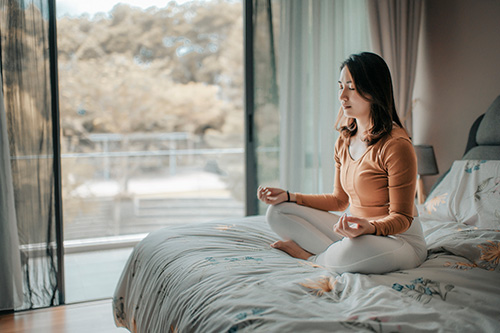You’re trying to meditate and just moments in, your mind is swept off to the events of yesterday or the plans for tomorrow… your noisy life.
You start again. Then, you need to shift your body. Your nose begins to itch. Your phone vibrates. Then your cat wanders in and rubs up against you.
That’s all normal — when you’re learning to meditate.

You may be tempted to give up. Most people are. But I urge you not to. Just the fact that you are reading this shows your wish to establish a committed routine, or to at least try it again. With a little effort, time and practice, you can meditate and reap its many benefits. So let’s talk about how to make it easy — which just requires a little shift in our mindset.
Benefits of meditation
To start with, don’t think about the goal of meditation — think instead about the benefits. Meditation is more of a process than a goal anyway. And what are the benefits? The answer to that question will be revealed as you practice and will likely include some or all of these rewards:
- You can explore our own mental patterns and processes.
- You become less engaged with idle chatter and judgmental thoughts.
- You become better acquainted and more in tune with your true nature.
- You are able to perceive things as they really are.
- The ego is subdued which allows humility, patience, contentment and gratitude to arise.
- Negative mental patterns are restructured and positivity, love and compassion form and expand.
That all sounds good to me and I suspect you might agree! But note that none of those benefits requires first that you quiet your mind and eliminate all distractions. You may reach such a place later, but don’t worry about it now.
So let’s start the meditation process again, shall we?
The basic guidelines
I encourage you to take a few moments to set yourself up with the best possible conditions to meditate. You don’t need to buy anything or go to a special space or plan to achieve a lofty goal.
Instead, just consider these guidelines:
- Find a comfortable position.
- Decide a set length of time to meditate.
- Choose an object of focus.
- Be prepared to remind yourself to focus on the object.
- Stay relaxed or keep returning to relaxation if necessary.
- Recognize your effort.
So, let’s dive into these suggestions a bit more.
A comfortable position
A meditation seat doesn’t have to be lotus posture with your legs folded like a pretzel. Choose any seated position that allows your physical body enough ease and support to take your mind away from physical distractions and that keeps your back erect, but not rigid.
Seated positions could be cross-legged, on a cushion or folded blanket, on the floor, against a wall, in a chair or resting on your shins. (Lying on your back is an option, too — but try not to fall asleep!) Let your hands rest in your lap. Then, either close your eyes or let the gaze drop gently downward.
Time
Set a timer! This way you won’t be tempted to sneak a peek at your phone or the clock. If all you have is 5 minutes to dedicate to meditation today, set that timer and commit to those 5 minutes.
Object of focus
Having an actual object to focus on is like setting an intention to keep you on track. Pick something to concentrate on. Perhaps you direct your awareness to your breath, a specific object, a place in the body, a mantra or an idea.
Our object of focus here will be the breath.
Elements to observe as you focus on your breath
- Texture — smooth or jagged?
- Temperature — warm, cool or neutral?
- Sensation — tip of the nose, back of the throat or elsewhere?
- Depth — deep, shallow or even?
- Movement— expansion and contraction of the lungs, heart or belly?
- Sound — loud, soft, in the back of your throat, or nothing?
As you meditate, you will continue the practice of observing and focusing on what you experience in your body while staying relaxed with each inhalation and exhalation as they naturally arise and disperse.
Coming back to your object of focus
You will find that you need to return to your object of focus, which in this case, is the breath. It’s inevitable and normal for many thoughts to pass through your mental space while meditating. So, a thought comes up — so what? You don’t need to be so attached to everything. Just come back to your breath — in, out, in, out.
When it happens again (and it will), don’t get bothered. Recognize it, remind yourself of what you’re doing, and come back to your intention: your breath. After more practice, the coming back and refocusing becomes easier, quicker and, eventually, less necessary.
Relax
It‘s extra challenging to stay calm and relaxed if you have the unhelpful expectation that you’re doing meditation wrong if you start thinking about other things while trying. Remember, thinking is normal and it’s going to happen, especially within the first few minutes of your practice.
Keep this fact in mind: you will catch yourself thinking. However, resisting thoughts and pushing them away is what sets you up for negative and frustrating emotions — and will further hinder your ability to relax and settle. Take a lighthearted and gentle approach. Be easy on yourself! Don’t resist. Relax.
Dedication
Recognize your effort. It’s not always easy to show up and give things a go, and you did. No matter how you think it went, you put effort toward this practice and that deserves your recognition and appreciation. And, whether you feel it now or not, you have benefited greatly and have created the opportunity to now offer up the fruits of the practice toward all beings around you and beyond you!
Your ability to practice travels with you
You can carry this practice anywhere and do it anytime…each morning or evening in your own home, at the beginning or end of your yoga practice, seated at your desk at work. Right now…
So, go ahead… get comfortable, set aside a few minutes, become interested in your own breath, come back to that breath when you get distracted, be gentle and relaxed, then recognize and dedicate your efforts.
You did it.
Try it again tomorrow. This path is a practice that we must show up for over and over again in order to receive its many and magnificent rewards.
 |
Discover more ideas for how to calm down and feel more peaceful with our article Calming everyday anxiety in women by Dr. Mary James, ND. |










